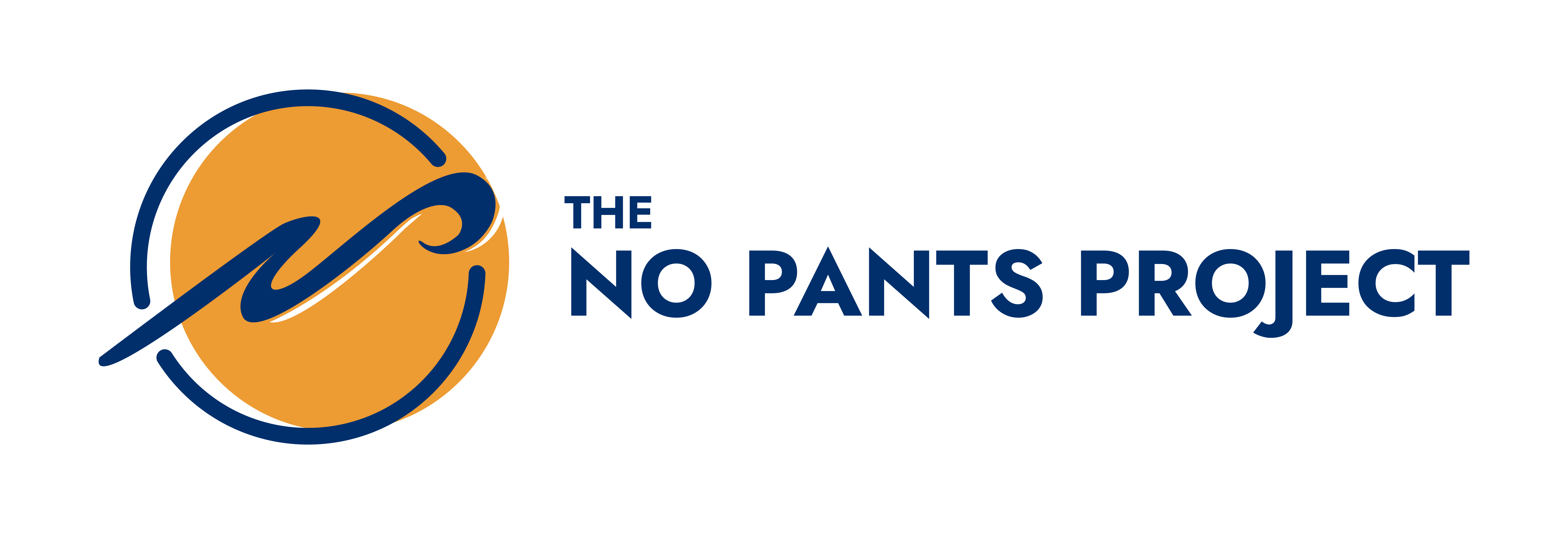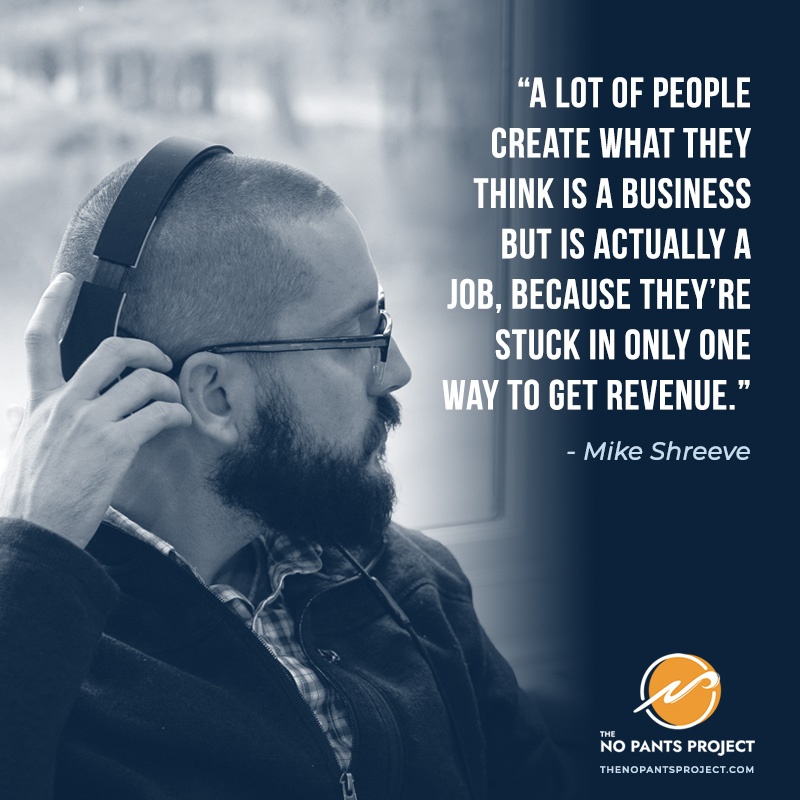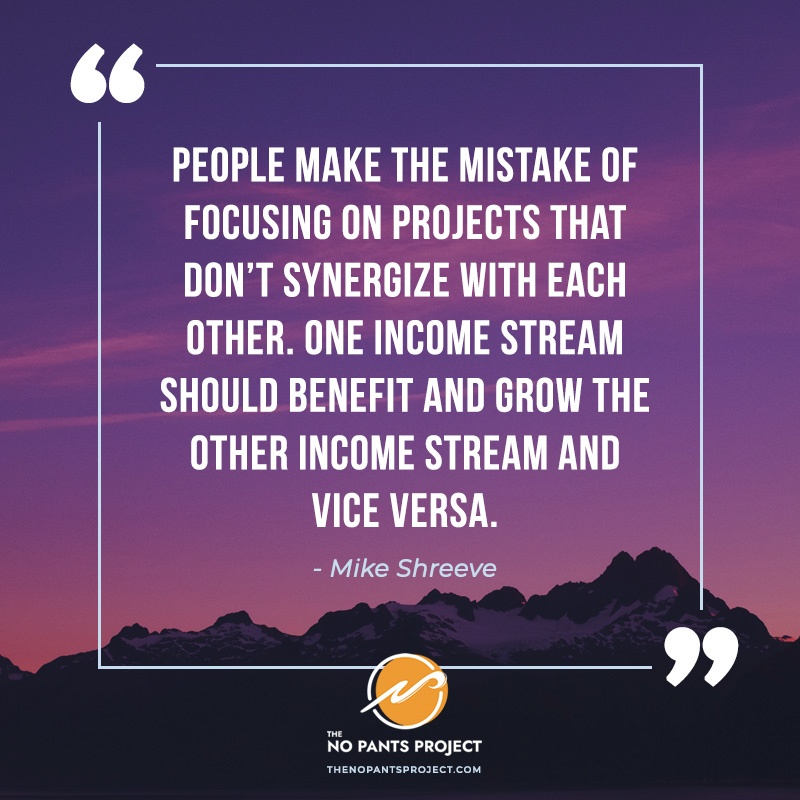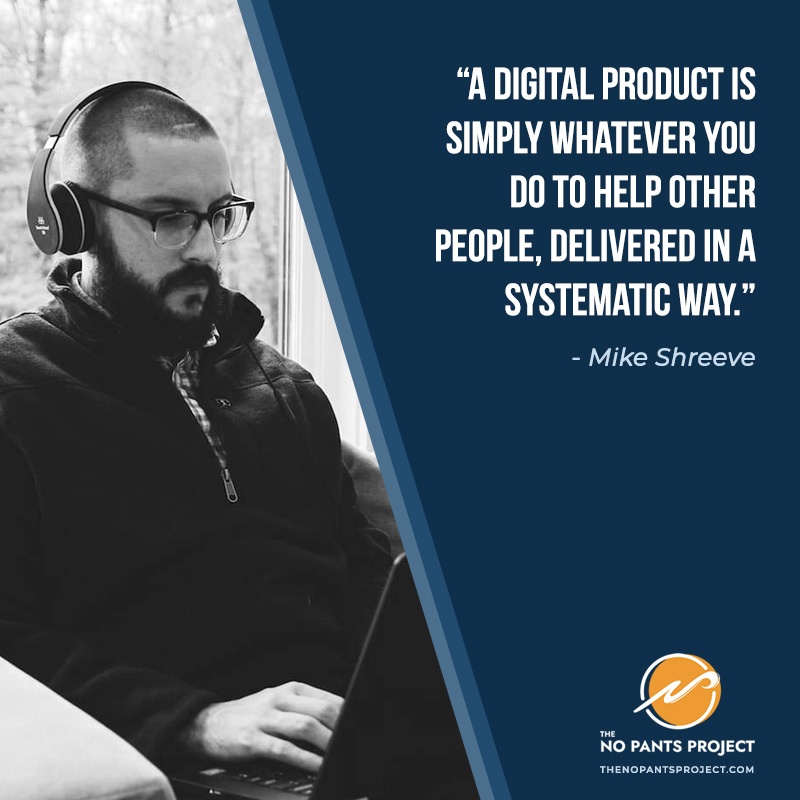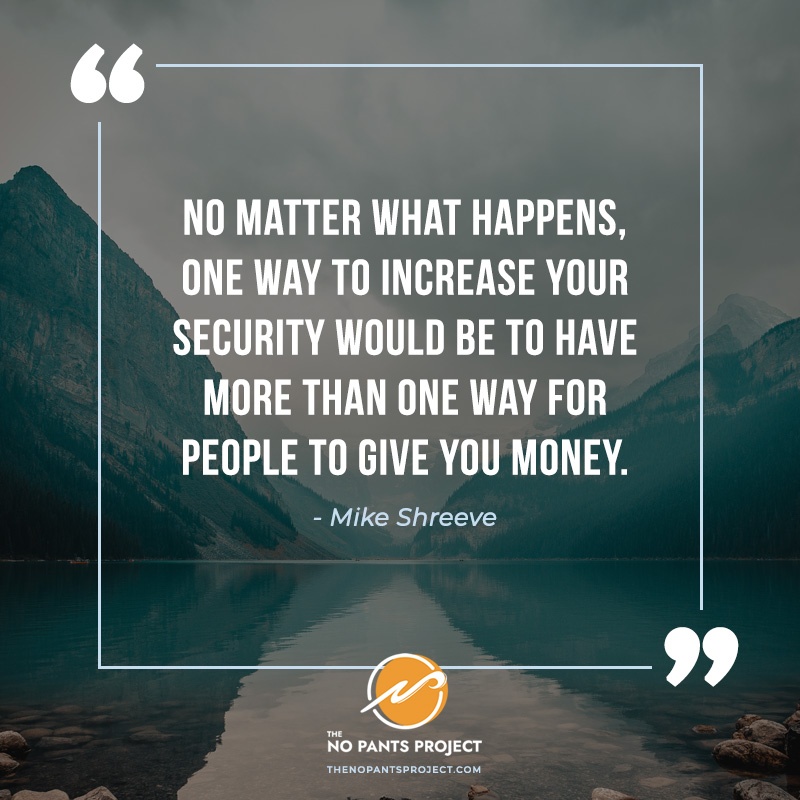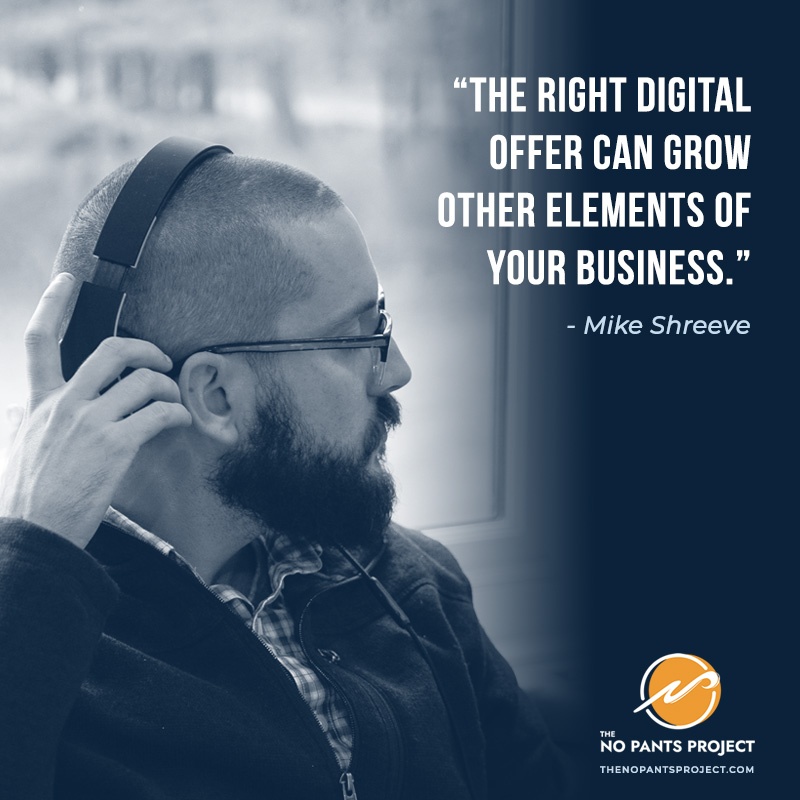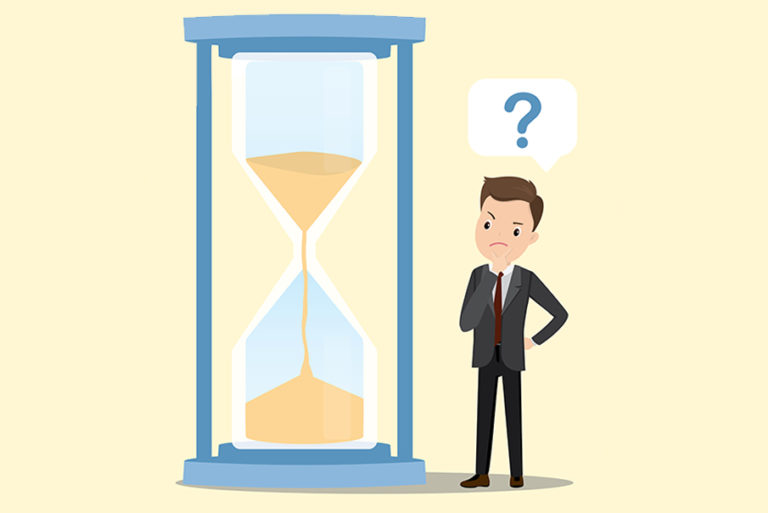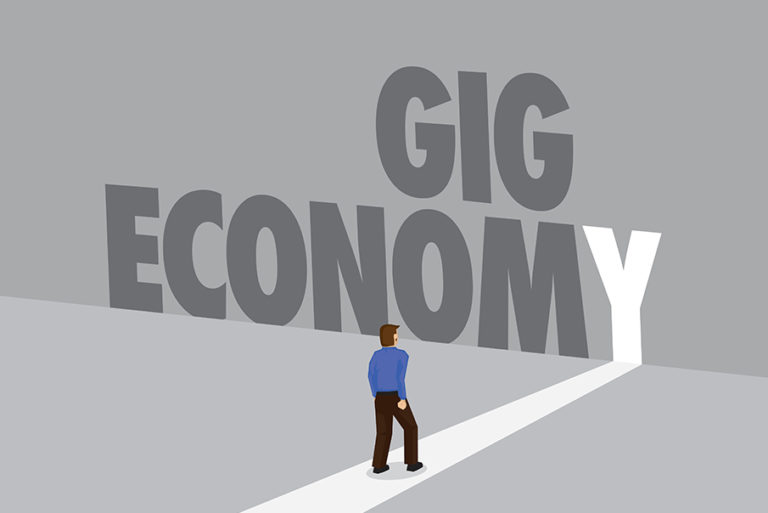Listen to this Podcast:
Listen on Anchor Listen on Spotify Listen on Apple Podcasts
SUMMARY
- In this episode: How I took one client to $50K per month just selling a $27 offer and how we were able to do that in three and a half to four months.
- A lot of people don’t have anything to sell, don’t know what to sell, or tried to sell something in the past but it didn’t work. At the end of the day, all the copy and funnel strategy is nothing compared to what you’re selling. Also, when the offer is done right, it’s something that can build the rest of your business.
- The most dangerous number in business is the number one. Businesses that only have one way to collect money and one marketing stream will feel the strain of the actual consequences of a lockdown.
- People make the mistake of focusing on projects that don’t synergize with each other. One income stream should benefit and grow the other income stream and vice versa.
- The most simple, subtle, and profoundly life-changing strategy that I’ve ever come across: Create a digital product that your dream clients will buy, that you can scale, and that prepares someone to buy your done-for-you service.
- Example: If you’re a copywriter who offers copywriting services, create a digital course that attracts your dream client for those services. Now you have two streams of income that are connected. Not only have you reduced the risk of having only one offer, you’re also probably increasing your prices on your DFY service because you have a big demand.
- Your product doesn’t have to be a course. There is a huge room in the marketplace for other things such as templates, tools, and challenges. A digital product is simply whatever you do to help other people, delivered in a systematic way.
- What do you want the product to do for you? Who do you want to buy the product, and why do you want them to buy it?
- What if you don’t know what you want your main thing to be?
- If you’re willing to be open, go see what sells really well in the market and ask if you can deliver similar results in a digital product. Once customers start coming in, ask them what else they want to buy.
- But there’s a human component to business, which is why I recommend that you think first about what you want the end result to be.
- Don’t try to make a $1,000 product right away. Start at a much lower barrier to entry. Make it easy on yourself to get lots of feedback and data very quickly.
- The cost to sell our client’s $37 offer is $42. But we’ve added in the economics so that we also make nearly $70 in total overall sales of other digital products, all within a 24-hour time frame.
- Funnel structure: Front-end offer —> Order bump —> Upsell
- This is the guaranteed way to make every funnel you do work, if you’re willing to put in the work.
- Once you have the funnel, you can use that new revenue stream to grow the main part of your business by sending emails to your $27, $37 buyers and nurturing them into your main stuff.
- When people want to solve their problems, they buy. And if you don’t have something for them to buy, they’re going to find someone else to buy from. The more things you have for sale, the less good you have to be at marketing.
HOT NEWS & DEALS
- Free Training! How I Scaled To $100k/Month+
For anyone serious about scaling their service business, this training will cover the 4 Stages To 7-Figure Growth. Perfect for the coach, consultant, or freelancer stuck in a hamster wheel business who wants to grow and scale. - 15 Ways To Double Profits During Hard Economic Times Report
Need a few tips to help you through the hard times? Download this 40+ guide and I’ll show you what I do to help businesses thrive during even down turns. - Download ‘The Anti-Commodity Formula’ Workbook!
Learn how to attract your ideal clients and customers, charge more than your competition, and build a business from a home that you love.
INSPIRATIONAL QUOTES
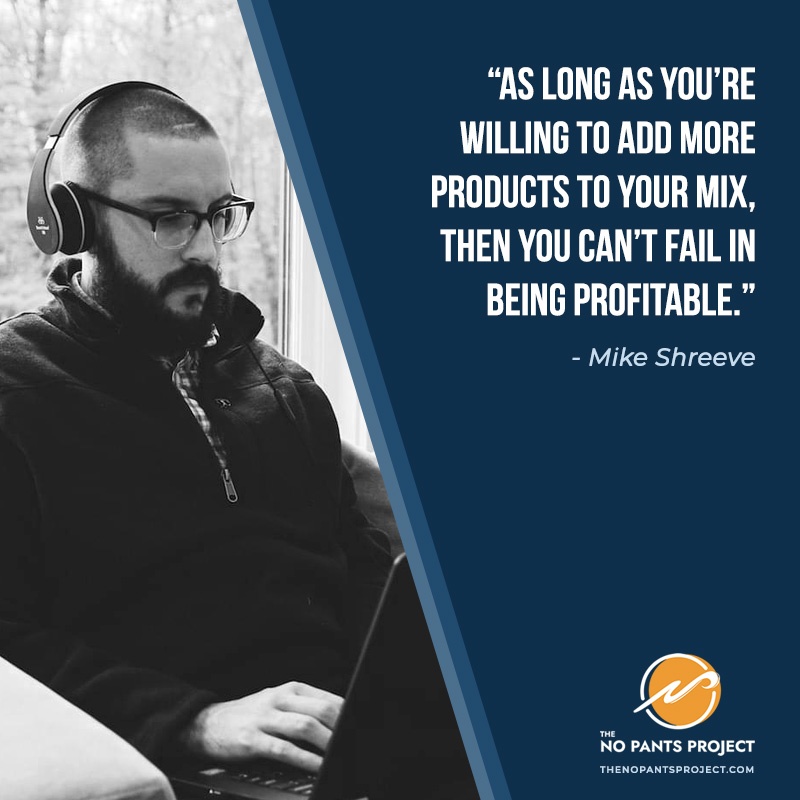
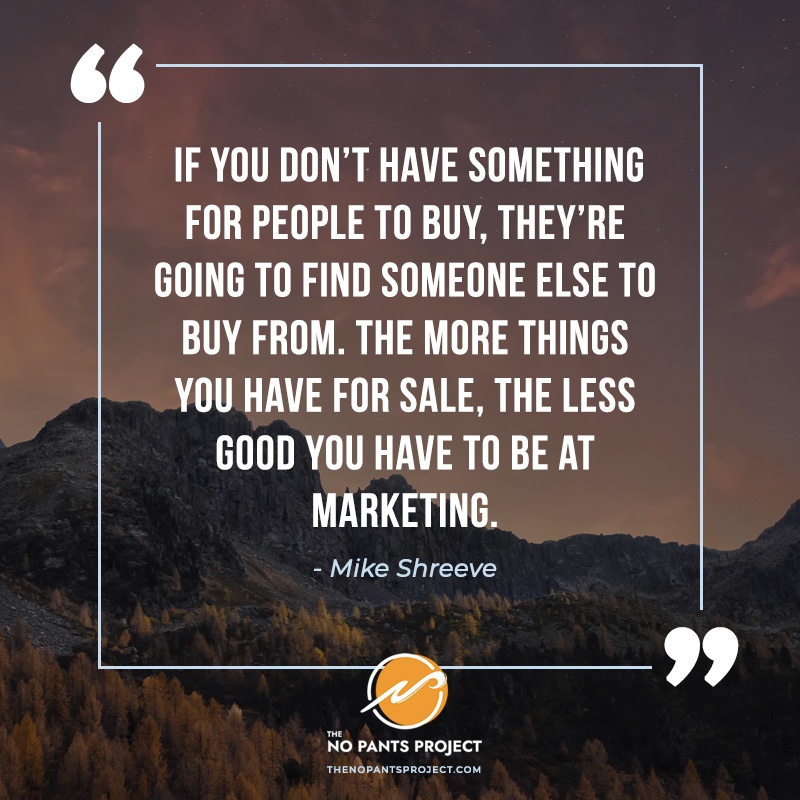
FULL TRANSCRIPT
Hello, my dear friends. I hope you’re doing well. Mike, Shreeve here. Welcome to this episode of the podcast we are full for the past couple of days, we’ve been doing a case study on how I took one client to $50,000 per month. Uh, just selling a $27 offer. And how are you able to do that in about three and a half, four months? And, uh, I realized that what I want to talk to you today about and teach you today, uh, it’s going to take awhile, so consider this sort of a long form lesson. And so we had to break out from email and that’s why we’re doing it in podcasting. Additionally, this is the mandatory plug here. Uh, if you go to the no pants, project.com forward slash done for you, we’re running a very special sort of close out and of type of situation until October 5th of 2020.
So this is going to be a permanent podcast. So it’ll be up there. Uh, if you come and, uh, book a call before October 5th, uh, as you’ve seen in the email, there are special things that will happen and all that kind of good stuff. We don’t need to talk about it here on the podcast. Again, it’s the no pants, project.com forward slash done for you. Okay. So mandatory plug out of the way. What I’m going to talk to you about here today is what we did specifically. The strategies that we used to select what to sell for this particular client. So a lot of people will see the numbers in the email that I sent yesterday, $50,000 a month. That’s that’s amazing. I love that. They’ll say I love the process. I love the idea of having a funnel that works for me 24 hours a day, seven days a week.
I love the fact that it’s scalable income, meaning, uh, it takes zero manual effort for me to generate that, that revenue. Um, I build it one time. It can run for months and months, and months and years. And you know, people love that. But the next thing they say is, but I don’t have anything to sell or I don’t know what to sell, or I tried to sell something in the past and it didn’t work. So today we’re going to talk about that because the funnel structure, the copywriting, the Facebook ad strategy, all of that stuff is important, but it’s not even close to the importance of what you’re selling, uh, because, uh, one, what you sell is what people buy. And I know that sounds obvious, but if you think about it at the end of the day, all the copy and all the funnel strategy is nothing compared to that moment where the person has to put in their credit card and in their mind, they’re thinking to themselves, what exactly am I buying right now?
That’s ultimately the, the turning point in how you collect money. So when they say, what exactly am I buying right now? If in their minds, they can say, it’s something pretty awesome. Then you’ve made your job 10 times easier. Um, so that, that, so that’s important cause the conversion aspect, but also the offer is if you do it right, something that can build the rest of your business. So what I want to talk to you specifically about is this idea that when you choose the right digital offer in the way that we do for our clients and we help our clients to, to select this. So I’m going to give you some frameworks, but if you’re thinking that to work with us, you have to have this done already. It’s not true. We do this for you. Our whole entire team does it actually. Um, and I, uh, weigh in specifically in an all that kind of good stuff.
But, uh, when you make the right offer, it can grow other elements of your business. And that’s very, very important because in this day and age, right now, with the way that things are, I am in a, in, um, I’m at a point where I feel like I’m begging people to diversify the revenue streams within their company. One of my earliest mentors says the most dangerous number in business is the number one. If you only have right now in your business, one way to collect money and one marketing stream, I would caution you that over the next couple of months, maybe year or more, uh, it, that, that very simple system of one offer one marketing channel is going to feel the strain of what we have yet to experience, which is the actual consequences of a lockdown. So this is not about politics and I’m not trying to fear monger.
I just want to point something out. We have had stimulus through. So in the United States, stimulus packages for businesses and individuals through the majority of our, uh, experience with the virus, a lot of that money is going to run out soon. They’re having troubles, getting more of it approved. It’s become very politicized depending on how things go. I mean, it’s all up in the air right now. Now I’m, I’m not sure what’s going to happen. I can’t predict that. What I can tell you though, is no matter what happens, one way to reduce your own personal stress and to increase your security would be to have more than one way for people to give you money. However, the danger with that is when people take this idea of I’m going to have multiple streams of income and they, they start focusing on projects that don’t for lack of a better word, synergize with each other.
In other words, one income stream should benefit and grow the other income stream and vice versa. It shouldn’t be that doing one income stream is a separate thing over here. And then this income stream is this other separate thing way over here. And then this income stream is unconnected and over here, because then what you’re doing is you’re taking your focus and you’re stretching it and displacing it and dispersing it. Instead. What you want to do is bring your multiple income streams together so that they gain momentum by functioning independently, specifically with digital courses, here’s the most simple, subtle, and I would say profoundly life-changing strategy that I’ve ever come across, create a digital product. And we’ll talk about what those are today. That’s what we’re gonna be talking about on the podcast that your dream clients will buy, okay? That you can scale. So you can go get a ton of them and they’ll give you money.
You don’t have to do anything to fulfill on the money they’ve given you because this is a digital product. So once they buy it, they consume it. And that’s what they bought. And that same digital product prepares someone to buy your done for you service. So let me break this down. If you are a copywriter, for example, and right now, the only way you get paid as a copywriter is if you write copy for someone that is a one offer, even though you might do different, you know, I do emails and I do sales letters and I do VSLs okay. But at the end of the day, what you’re selling is your time as a copywriter to clients. That’s one offer. So you’re at risk to minimize that risk and to make sure that everything’s connected so that you’re not dispersing. So you’re working on the same business. You’re building the same business, even though there’s multiple revenue streams in that business, you create a digital course that
Meaning the people who want to buy it, your dream client for your copywriting service. Now you have two streams of income that are connected because as your digital product business grows and you get more and more customers, you now have a larger and larger base of individuals that you can communicate with in, you can email them. And you know, if they’re buying things from you, that means you probably have their address depending on how you’ve set it up, which means you can send them something in the mail. And you can say, Hey, uh, I know that you bought this digital course. And that means you’ve spent some time with me, cause I probably put some videos in there and you know, I’m one sided, but you were consuming my content. And so, you know a little bit about me, maybe I’ve helped you a little bit with this digital course.
Would you be interested in me helping you more with this done for you service? Now you’ve reduced the risk of having only one offer. Okay? Now there’s a whole bunch of other things going on as well. You’re probably increasing your prices on your done for you service because now you have a big demand where before you might have done cold prospecting or people don’t know you. If they bought a digital product from you, they’ve likely spent some time consuming it. They likely liked it. If you did a good job. And so they’re way warmer than you’ve probably ever experienced before. If you do a good job. And so when you communicate with them, Hey, I have this other thing for sale. It’s a completely different experience. And demand is created every single day as you sell multiples of these digital products.
And so this is, this is the example of adding multiple revenue streams, but making sure that they’re connected so that the growth of one benefits the other. Now let’s say life gets to a situation and the world is in a crazy place where nobody wants to pay your fees because they’re really high. Or let’s say you get sick, or let’s say you want to take a break or let’s say, you just don’t want to do done for you for a little while. It’s easier to make that decision when you are empowered by that second income stream. Now I’ll give you the example of the client that we’re talking about. In this case study. When he came to us, he had an existing freelancing business. I’m not gonna give the way the specifics, because I don’t want people copying him. He paid us a lot of money to help him and get these kinds of results.
I’m not gonna give that away for free, but he had an existing freelancing business. He was doing some client work, but he wanted to add this second income stream. Well, when we first started, he was all client, client, client, client, client. Now, uh, I am, I didn’t need to double triple check with him. I think he might have like one or two clients left, but he certainly is not selling into new client work because he doesn’t have to. Would you, if you were doing $50,000 a month, so this is, I want to emphasize to you the power of this kind of strategic thinking. I know the podcast is supposed to be about products and we’re going to get there and what kind of products to sell. But I want you to adopt this way of thinking about your business because a lot of people create a business.
Well, they think it’s a business, but it’s actually a job because they’re stuck in only one way to get revenue. And you saw this year that there were a lot of companies that were completely, I mean, I don’t want to sound over the top, but obliterated overnight because their entire business model depended on a certain thing, a live event in person connections. I mean, I’m not going to name names, but there were a few of my previous clients whose entire businesses were essentially shut down overnight. Why? Because their business model was one offering all those public speakers that we love, who would get paid $40,000 to give a speech guess what’s happened to them this year, no more speeches, all those big personal development gurus that have these big live events. And that’s where they do most of their revenue. Guess what happened this year gone?
So this is, I mean, look, we’re gonna get to the products I promise. But more importantly, I want you to think about this stuff in your business and ask yourself, you know, this is, this is why we created the done for you service in the no pants project. It’s not because we need the money. It’s not because we didn’t have multiple sources of, of revenue. We have multiple products to sell. We have multiple ways to make money in the company is because we, for years, I’ve been mentioning to people, you gotta get a funnel up selling a digital product of some kind to hedge against events like this. Now, again, I’m not a future teller. I don’t know what’s going to happen in the future, but how this year has gone so far, I’m doubling down on diversifying my own income just to stay safe.
Okay. So that PSA out of the way, and with your understanding of why we’re doing this, let’s talk about how do you determine what to sell? Well, the first thing that I want you to understand is that it doesn’t have to be a course. A lot of the clients that come to us when we do this with them, they say, okay, you know what? Um, I don’t feel like an expert. I don’t feel like I can stand up and talk about something for several hours and teach someone something. And my answer to that is fantastic. Good. Because first off, it’s great to have that awareness about yourself and not try to like scam people out of money by pretending to be something you aren’t. But secondly, is that there is a huge room in the marketplace for things other than product or other than courses.
So there are templates, there are tools, there are, uh, like a challenges. So for example, let’s say that you don’t really feel confident that you could teach someone how to make a course and launch it and do a six figure launch, et cetera, et cetera. But you’re amazing at organizing things. Well, what if you deconstructed the process of launching a product and put together a five day challenge where you’ve literally made like these mega Epic checklists of everything somebody needs to do to launch a product and it’s in this beautiful, it’s like formed out into SOP. I mean, it was just standard operating procedure and you have a checklist and somebody could buy that, take it to their business. And they could just sit there and use your checklist. And it would be the most stress free launch they’ve ever had. Do you think that that would be helpful to someone and the answer is of course, yes, it is.
Uh, there are a lot of people who sell those types of things and they do very, very well. And that is a 0% course. It is instead a set of digital tools, right? You could do. Maybe you’re a designer. Well, couldn’t you put together 15, let’s say you’re a funnel designer. Let’s say you bought a Katherine Jones is funnel hacking thing. I love Katherine. She’s awesome. I met her at a mastermind a long time ago. Amazing person, Catherine Jones, funnel, design hacking program, whatever it is, where she teaches you, how to be a funnel designer. Okay, well, couldn’t you put together 15 predesigned funnels in one pack. Of course you would. I mean, who it, you could and people would love it. The people who bought it, because the number of people who actually know how to design a funnel is like 10. There’s not very many people know how to do it. They want convenience. They want tools. A course is not the only thing. Now, this particular client that we helped in this case did kind of a hybrid both course and tools.
And that’s, I want you more than anything from this podcast to realize that a digital product is simply and whatever you do to help other people, this is what a digital product is, whatever you do to help other people delivered in a systematic way. In other words, I can write you a sales letter, but I can also show you how I write a sales letter. And that’s what in the no pants project is our letter system program. I literally just sat down and showed you everything. I know about writing sales letters, how I write sales letters, the process, et cetera, et cetera, et cetera. So I could also have sold for not as much as we sell a letter system for it, but I could also have sold sales letter tools, maybe worksheets that you could take and fill out that the worksheet is basically my thought process in a worksheet that allows you to think through finding the big idea for your next promotion, and then how to take that big idea, pop it into a sales letter template. And that could be a digital product.
Now, the beautiful thing about the digital world is it’s not just for business stuff and marketing stuff. One of our other clients hasn’t quite hit $50,000 a month yet. I think she’s at around 35 40. She teaches people story and not story for business, but story for fiction story for screenwriting, uh, the, the, the digital economy, meaning digital products, digital, digital, all that kind of stuff. Um, these courses and tools and templates and all that is it’s significantly bigger than you could probably possibly ever imagine. One place to go to see the scale and to see some numbers would be to go to U Demi or Udemy, or I didn’t know. I never say it right. U D E M Y go look at some of their courses and you will see 30 to 40,000 students in these courses. And you, to me, isn’t like running tons of ads and they’re not doing a great job marketing themselves.
They just have a really big platform. That’s kind of grown by word of mouth. I mean, not a hundred percent word of mouth. They do run ads, but it’s not like they’re pushing as that. You know, they’re not putting together funnels. They’re not doing a lot of the marketing, right? And so you can go to their platform and see all these different courses and see the broad range of courses. Um, I have a really good friend who has a very successful $350,000 per year business. Okay. This is his business. He teaches people how to play piano. That’s it that’s the whole business. And he doesn’t, he doesn’t do any done for you. Doesn’t do anything like that. He just teaches people how to play piano online.
And you think to yourself, there’s no way he’s doing $350,000 a year. Is there really that much demand? And the answer is yes. So the first thing that we do when we work with clients, the first thing we did with this particular client is we look at what do you want the product to do for you? And the best way to answer that is who do you want to buy the product? And why do you want them to buy it? So in the case of this client, when he came to us, he was done for you, heavy, meaning he was mostly doing done for you in his business. And he was doing, you know, he’s doing great. He’s very good. You know, he’s good at what he does.
What we wanted to do is make sure that the people who purchased his product were the same people who could potentially hire him for done for you. And what that does, is it shapes what you could offer? Let me give you a really good example. Let’s say that I want to be a writing coach. Okay. I want to coach people how to be a writer. What I should do is go to the market with a course or maybe a template. So I could do a, I could do a course on how to be a freelance writer, or I could do a template, um, you know, use this template to get your freelance writing clients. So I go to the market and the people who are buying are
Brand new writers or people who are, you know, they’re maybe they’re struggling in their business, right? So they need some help. They buy up this course. And then I come back and I say, Hey, look, I would love to coach you in your writing career. That makes sense, right? It’s logical. It’s, uh, what I want to do in the end shaped the course that I created and it shaped who the customers are going to be and why I have them and et cetera, the wrong way to do this. If I wanted to be a writing coach would be to go out and sell how to sell more digital products with this secret copywriting formula. Now, why would that be the wrong way to become a writing coach? Well, because the majority of the people who buy that are probably not trying to become writers. Now, I might be able to sell them copywriting critique style services.
So again, it’s important to know what you want to sell, but it doesn’t necessarily mean that I could sell how to be a writer coaching services. Does that make sense? It’s an important nuance and this is sometimes we get so hung up on, yes, I’m ready to launch that. I want to launch something. I want to launch something. And we don’t put in the thought to create the connection between what we’re doing on the front end, which is what these offers are and what we’re trying to do on the backend. Okay. So very important, uh, when you create your products to think through that process, because again, we’re looking to take one income stream and make sure that as it succeeds, it helps the other income stream succeed as well. Now here’s a question I get a lot, which is, well, what if I don’t know what I want my, what we call backend, which is what maybe what if I don’t know what I want my main thing to be.
I don’t know if I want to be a coach. I don’t know if I want to be a done for you person. I don’t know what I want to do yet. There’s two philosophies on this and I take this on a case by case basis. One is if you’re willing to be open, then what you really do is you just go see what sells really well in the market. And you say, can I deliver similar results in a digital product? If so, then my funnel is just going to be the funnel. That that’s one, all one of the good funnels. Then what I do is once those customers start coming in, I’ll just ask them what else they want to buy. To be honest, this is the smart objectively wise way to build a business, go figure out what’s selling really well, make a better version of it, ask your customers what else they want to buy.
That’s a really easy way to make a lot of money, but it means it’s missing the human component, right? Um, I mean, if I want to do that, I would just go rent a Lamborghini and just go create Lamborghini funnels because those do really, really well. And they sell really well. And then I could just, once people buy the Lamborghini funnel, I can do the, whatever the rented jet funnel and the fake mansion funnel, right? Like those do sell, but there’s a human component to business. And this is why I recommend that you think first about what you want the end result to be specifically, either get help. So when clients come to us, one of the things that I helped them do is create those backend offers. So we start looking at, okay, what do we want this to end up being? What do you want to end up doing in your business?
Let’s work through that. I’ll coach you through that. You know, we can figure out what those offers are. So get help with it, whether it’s me or someone else get help trying to figure out what that main thing is going to be. And, and, and something that you enjoy and something that you are, uh, you don’t have to be passionate about it. I don’t think, uh, we constantly need to be feeling 110% passion over every single thing that we do. Cause thing I’m passionate about is living my life, not working for a living, uh, but get some help figuring what that out, what that is, or spend time building that part of your business first.
Okay. Those are really the options. So you can spend that time and say, okay, look, step one. I’m going to go figure out what my main thing is. First, I’m going to send out some emails. I’m going to do LinkedIn. I’m going to figure that part out. I can get some clients under my belt and then I’ll add the second revenue stream. Or if you’re going to do both at the same time, make sure you team up with somebody who knows what the heck they’re doing. So for that question, I know it’s a big question for a lot of the people here in the no pants. What exactly do I offer in that regard? I think those are the realistic options. Okay. I mean, I could give you some pie in the sky, stuff about, take a personality test and then, you know, it’ll all come together.
But I think those are probably the more realistic options for you. Nothing is personality test. I love him. What color is my parachute was a very helpful one for me. Um, okay. So we have the who and the why. The next thing that I would consider is when you make your products, don’t try to make a thousand dollar product. Not at first, Oh man. That’s in my opinion, some of the worst advice that’s going around right now, online because the amount of people getting in situations where they have high refund rates, because they don’t have experience creating products. And they just, somebody told them, you need to make a thousand dollar product and you make a $5,000 product and they don’t really know what they’re talking about. And then they get into all these bad refunds. Like it’s really bad. It’s very bad in this industry.
That, that happens a lot. It, it, um, in almost every other industry, you have to put in some time doing lesser tasks before you’re able to do the big one. So like, if you’re training to be a pilot, you don’t get to fly the big seven four sevens until you’ve learned to fly the little Cessna one fifties. Right? So my recommendation for those getting in the course and digital product business is don’t try to tackle a thousand dollar program for your first thing. Instead, sell something for 27 bucks. The client that we have, who’s doing $50,000 a month. The price point on their front end offer is $37. It’s a great $37 product. It didn’t take him months to create.
Got it done. Quick, put out in the market quick, got results. Quick, got testimonials. Quick, got feedback. Quick, made a judge made adjustments quick. All those things are very difficult to do at a thousand dollars because when you sell something for a little bit of money, and now, now please hear me out. So those of you who have been listening to some of my other stuff, you’re thinking about Mike, you said, if I do a, you know, if I got to the market, I need to charge something for a lot of money. Yes. When you do done for you. Cause when you do done for you, you need to charge a lot of money. So you can devote time and energy and focus to doing a good job. When you undercut your prices and done for you, you create situations where you fail to deliver because you haven’t given yourself enough space to be a human being, to have the focus and mental energy and things like that.
But in digital products where it requires zero of your time after you’ve created it, right? So you create it once. I highly recommend that you start at a much lower barrier to entry, make it easy on yourself and make it easy on yourself to get lots of feedback and data very, very quickly because to sell 20, $37 offers a day, that’s 20 customers day, who can tell you if it’s good, who can say, this is missing to say, I was confused here, can you fix this? Can you to have 20 customers a day? It’s rather easy to have 20 customers a month at the thousand dollar level, the mechanics at play to sell that easy is not a word that I would use to describe that process. So you can get a lot more data, a lot more quickly to improve the offer, to learn from your experience. And then you can make quicker, faster iterations to get to profit. So that’s why I recommend low ticket. It’s just less intimidating.
Next
Is, uh, any, you know, that’s why we do all of our, all of our clients. We say low ticket. We don’t do high ticket funnels for our clients because it would just, it would take forever. It would just take way too long, way, way, way too long. You can get a two X return on ad spend on a $27 offer. And I know plenty of people who are running webinars, selling a thousand dollar offer who would kill for a two X return on ad spend. Look to me, it’s the same return on ad spend, whether it’s coming in at a thousand dollars, a pop through a webinar, I have to give every week or whether it’s coming in at $27 a pop and then I’m completely disconnected from it. Two X is two X getting $2 back for every dollar is getting $2 back for every dollar.
So I’m going to do the one that’s faster, easier, quicker, you know, in the no pants project we’re currently working on four of these funnels internally and we’re, and we’re just launching them one after another one after another one after another. Because even if the funnel only does, you know, $10,000 a month in profit times four that’s $40,000 a month in profit. Now a $10,000 a month funnel. So a funnel that produces $10,000 a month in profit, isn’t really a scaled funnel, right? I mean, you can get much bigger numbers off of that. Once you have it all dialed in and you know, you’ve rewritten the sales page. A bunch of times, you’ve got your, you improve your offer and all that kind of stuff. Like there’s a lot of work to get there, but that’s not even really a scaled a funnel. So I’m just trying to give you guys some ideas as you think about this in your own business. Now, once you know who it’s for, why you’re doing it, you know, you’re going to do low ticket, a really important aspect of why we were able to get this client to be so profitable. So quickly comes down. Very simple
Economics, most marketing problems. Aren’t actually marketing problems. It’s problems of economics. It is, I would say in the year 20, 20 impossible to profit off of a $27 offer. I it’s impossible. Uh, the cost to sell our clients $37 offer is about $42. So every time we make a $37 offer, we’ve spent $42 in ads. Now some of you are like, Oh no, that’s that’s net negative. That’s horrible. Except that we’ve added in the economics. So that every time we spend $42, yeah, we make a $37 sale. But we also make about snidely seventies, like 66 or $67 in total overall sales of other digital products all within a 24 hour timeframe. So how we do it, it’s very simple. If you don’t know these words, that’s okay. This isn’t a full, complete masterclass on how we do these funnels. Every funnel that we build for our clients has a front end offer.
That’s anywhere from seven to $47. It has an order bump. You can think of an order bump like the candy bars at a cash register checkout. So you’ve bought all your groceries. You come to the checkout and they’re basically saying, do you want some candy bars or magazines or whatever? So the order bump is just another very small digital product could be templates could be training. It could be all sorts of different things that we sell. Um, the order page. So you have a front end sales page, it’s selling a $27 offer. Then you have this beautiful order page with an order bump. Some people take it on average, about 30% of the people take that order bump. And then we have what’s called an upsell, which is to see, to see it in the real world. Would you like fries with that? That’s what it is.
Okay. So you buy the burger, they say, what’d you like fries with that? You say, yeah, great. Or no, not at this time. So we have the upsell and then that’s it. So between the frontend, the order bump and the upsell that allows us, the economics, meaning the availability of other offers and, and a certain percentage of those people buying those other offers equals our ability to spend $42 in ads to sell a $37 offer and make about two times what I say, 47 $42, I think is what we’re spending $42 to spend, spend $42. Um, all of this is in my memory, $42 to sell a $37 offer and to basically around ish, depending on the day two X, the return on ad spend.
So the really powerful thing to understand about that concept is that it is the guaranteed way to make every funnel you ever do work. And I think this is really important because a lot of people are afraid to build these digital courses. And they’re afraid to build these funnels because they’re afraid that their stuff won’t sell enough to be profitable. And my response to that is as long as you’re willing to sell other stuff, also to add more products to your mix, then you can’t fail in being profitable. Now, please don’t get it twisted. It takes work to test things, to come up with the product ideas that will work. It doesn’t always work from day one. As you saw the email that I sent yesterday, the first month that we worked with this client was a net negative month. So the last week of whatever that first month was, and then the first half of that next month, we lost money. We lost like $50. We were making sales, but not profitably. Then we made some tweaks and we changed some things and we changed some more things and we changed some more things. We made some tweaks, we changed them. And now these three, four months later, $50,000 a month.
So when you are looking at potentially going down this road of creating your own digital products, as long as you understand that, it’s not about getting it perfect the first time as I said in yesterday’s email, but also that you always have the ability to work your way out of a bad funnel situation. Meaning let’s say it’s costing you $60 to sell a $37 offer. You just can add more, offers, more products, and the math will work out in your favor. Now, again, we don’t have time right now to get into how you would do that. There’s things like down sells. There’s automated followup sequences. There’s cross selling. There’s contextual selling within the membership itself. There’s affiliates. There’s, there’s a hundred different ways to add that element of economics, the element of math, right? So if it costs you $60 to make a sale, figure out how to get more than $60 in other products that people will buy once they buy that front end thing, that’s always available to you, which means if you’re willing to put in the work, this is a guaranteed process.
Now the, the where the, where things get sketchy is are you willing to put in the work? That’s where the guarantee breaks down? One of the things that I highly recommend that people do is once they have this funnel, even if the funnel is F for every $60 that you spend, you only make $61, the fastest and easiest way to use that new revenue stream in your business to grow. The main part of your business would be to send emails, just like I sent you an email. Now you’re listening to this right now, send emails to the people who bought your product and say, I have this for sale. So my done for you, whatever it might be, make sure it’s priced appropriately. And to nurture those 27 $37 buyers into your main stuff, two thousand three thousand five thousand dollar offers. If you’re in our peaceful profits program that we teach you how to make.
Now you could spend, you know, a thousand dollars a day at $60 out and $61 back in, and he might not be making a ton money on the front end, meaning that funnel might not be producing a lot of cash, but it is filling your phone calls with clients or prospects who have spent time consuming the course or the template that you’ve created. And if you’ve done a good job, and if you work with us, we’ll help to make sure that you do a good job. If you’ve done a good job on the product, if you’ve done a good job, helping someone in that digital course situation, then the end result is they really like you. They tested you at $27. They pulled out their card and they tested you. And now they saw what value they received. You help them a little bit. And now they’re ready to buy from you.
Many of you who are listening to the sound of my voice, that’s how you and I have done business. In the past, you bought something from me. You were happy with the experience. And so you bought something else that is a natural pattern of buyer behavior. And there’s something that’s really, really important. I want to make sure people understand here, the buyer who bought your $27 thing with whether you help them or not, whether you offer them something else or not, they’re going to go like they’re going to go buy something. It’s like, you know, a mentor of mine explained it really, really well. When you go to Starbucks in the morning and you buy their coffee. By the end of the day, you’ve bought other food stuff.
So whether that’s, uh, you bought breakfast or you went to the grocery store or you had lunch or something. So think about that for a second. You, as a buyer are constantly buying things. If you have a pain, your interest is not so much in who you’re buying from as much as solving the pain. In other words, somebody who comes in at your $27 offer, if they really need help, which is probably why they bought your templates or your course, or whatever, they really want to do this thing. You really want to learn piano, which you don’t think that, you know, that’s not a huge pain, but they have a desire. And they’re trying to scratch this itch. If I really want to learn how to, how to play piano. So they buy the piano course for $27 and then never hear from you. Again, you have nothing else to teach them, except for what you put in that $27 course, you have no other way to help them, except for what you put in that $27 course.
Well, what are they going to do? They’re not going to sit and wait for you. They’re going to go buy some piano books. They’re going to go find another virtual piano teaching process. They’re going to find other people to teach them one on one. So this idea, I think sometimes we, we get, we buy into myths about what buyers are like. Um, and the reality is that when people want to solve their problems, they buy and buy and buy and buy. And if you don’t have something for them to buy, they’re going to go find someone else to buy from. Okay. Now obviously we need to make sure that what we’re offering is ethical, that what we’re doing for people is helpful, uh, but understand how people work. Um, and what that will allow you to do is to build very successful businesses based off of the economics of products, which is the more products you have, the more things you have for sale, the less good you have to be at marketing because the math works out in your favor every single time.
So I hope that this episode has been helpful. I realized that we’re about, about 15 minutes in. I tend to do this. Think to myself, it’s going to be 30 minutes and ends up being 50. I could go on and on. And, and to be honest, um, this case study, as we’re talking about this particular client, I don’t have it really planned. I’m not, I didn’t like sit down and ha I’m going to make this break case study and get a bunch of clients. I literally am just trying to share some stuff that we’ve learned from helping this particular client. Because as of October 5th, uh, those of you who are on our email list or who came here from the email list, you know that after October 5th, there’s going to be a big change to how we do done for you. And so if you would like to work with us and I can help you through choosing what to sell, I can help you through the copywriting and the building, and we’ll run your ads.
And we do all these different things for the client. When we worked together at the no pants, project.com forward slash done for you, if you would like me to be involved in that process with you, uh, you have to book a call with our team before October 5th, after that we’re making some changes to how we’re processing done for use, um, and details are all in the email about that. Uh, so, um, anyways, like I said, I could go on for literally hours and hours for the past year and then opens project. This is all that we’ve lived and breathed was these funnels, figuring out what offers work, what offers don’t work. Um, we have an incredible team that helps people. Um, but hopefully this episode has given you an insight into maybe not how simple, cause I mean, this isn’t necessarily simple. I wouldn’t call this process simple, getting clients for a done for you.
That’s a simple process, right? You figure out what you can help people with and then you go find them and you talk to them and you do that thing for them. This is a little bit more complex. But what I do hope is that you can see that it’s not terribly difficult, meaning hopefully through this episode, you’ve had some ideas about what you might do for your own digital product funnel. I also sincerely hope that you take very seriously the admonition to avoid only one income source in your business. Uh, especially considering all of the craziness that’s going on in the world. If you get nothing else from this podcast, it that’s what I, I sincerely hope you take away from that is that you actively engage in some thing, whether it’s working with us, whether it’s buying some of our stuff, whereas buying somebody else’s stuff, it doesn’t matter to me do something to decrease the risk.
Um, I would say the horizon looks bumpy regardless of what happens at the time of this recording in the next month or two. Uh, I, I, there’s just a lot of things that, um, have me thinking, it’s time to sort of button up some of the hatches, get storm ready, uh, and make smart business decisions about how to minimize the risk of one and how to start getting some momentum in other areas of your business in an interconnected way so that they are working off of each other. So that in case one goes out the other one’s still there. And even while this other one, you know, this other revenue stream or income stream might be out for a minute, it still is improving your business. That’s ultimately what we’re looking for. Okay. My friends that is it for me. Uh, we have a few things to get through in the no pants project.
We’ve been wildly building an absolutely amazing team. There are some major for us. Um, there’s major changes in how we’re going to be sending emails in the future and how we’re going to be running content and all that kind of good stuff. So I don’t want to make promises that I can’t deliver on, but, uh, I do believe that I’ll be getting back into podcasting here relatively soon. Cause the beautiful thing about a podcast is I could record a month of podcasting on like in one day, which is great. That’s the beautiful thing about this kind of medium, um, and uh, and a whole bunch of other changes. So just really, really excited for what’s going on. Our business is growing. Uh, for those of you who are worried about what the market is like, uh, from our standpoint, uh, we’re having a great year.
Um, we are, like I said, we’re growing like crazy. Um, we have noticed, uh, that sales are still taking place though. There is some, uh, there’s some apprehension. So again, as a business, we’re rolling out multiple low ticket funnels. We’re hedging against relying on only one single source of income, which we never really have. It’s not that makes me nervous. I’ve I’ve not won. I’ve not been that way since I’d say probably like 2011. Uh, I just, I don’t make that mistake anymore. Um, but we are looking to expand multiple sources of new sales and leads and things like that. So we’re definitely growing. I encourage you to not wait to grow. Uh, you know, if you have, if anything has taught me about 2020, is that the, um, the dynamic and the atmosphere can change in a matter of two or three weeks. So don’t think that in the future, I’ll get to it because you quite sincerely have no idea what the future is going to hold.
Um, I thinking back to January of this year, I don’t think anyone was very seriously thinking, uh, what happened in March was going to happen. Uh, certainly not, uh, you know where we are now. So anyways, I’m rambling now at this point, I miss talking to you guys, I’m gonna try and get more podcasts out. Uh, as soon as I possibly can got some things on our end, I hope this has been helpful. Again, if you want us to help you to build your own funnels, that’s the no pants, project.com forward slash done for you. Call us before October 5th to get in on the current way that we do things. Um, again, details in the email. I hope you all have a beautiful rest of your day and I’ll talk to you later.
